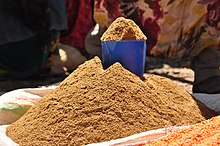Sorghum (/ˈsɔːrɡəm/) is a genus of about 25 species of flowering plants in the grass family (Poaceae). Some of these species are grown as cereals for human consumption and some in pastures for animals. One species is grown for grain, while many others are used as fodder plants, either cultivated in warm climates worldwide or naturalized in pasture lands.
Taxonomy
Sorghum is in the Poaceae (grass) subfamily Panicoideae and the tribe Andropogoneae (the same as maize, big bluestem and sugarcane).
Species
Accepted species recorded include:
Sorghum at a West African market
- Sorghum amplum – northwestern Australia
- Sorghum angustum – Queensland
- Sorghum arundinaceum – Africa, Indian Subcontinent, Madagascar, islands of the western Indian Ocean
- Sorghum bicolor – cultivated sorghum, often individually called sorghum, also known as durra, jowari, or milo. Native to Sahel region of Africa; naturalized in many places
- Sorghum brachypodum – Northern Territory of Australia
- Sorghum bulbosum – Northern Territory, Western Australia
- Sorghum burmahicum – Thailand, Myanmar
- Sorghum controversum – India
- Sorghum × drummondii – Sahel and West Africa
- Sorghum ecarinatum – Northern Territory, Western Australia
- Sorghum exstans – Northern Territory of Australia
- Sorghum grande – Northern Territory, Queensland
- Sorghum halepense – Johnson grass – North Africa, islands of eastern Atlantic, southern Asia from Lebanon to Vietnam; naturalized in East Asia, Australia, the Americas
- Sorghum interjectum – Northern Territory, Western Australia
- Sorghum intrans – Northern Territory, Western Australia
- Sorghum laxiflorum – Philippines, Lesser Sunda Islands, Sulawesi, New Guinea, northern Australia
- Sorghum leiocladum – Queensland, New South Wales, Victoria
- Sorghum macrospermum – Northern Territory of Australia
- Sorghum matarankense – Northern Territory, Western Australia
- Sorghum nitidum – East Asia, Indian Subcontinent, Southeast Asia, New Guinea, Micronesia
- Sorghum plumosum – Australia, New Guinea, Indonesia
- Sorghum propinquum – China, Indian Subcontinent, Southeast Asia, New Guinea, Christmas Island, Micronesia, Cook Islands
- Sorghum purpureosericeum – Sahel from Mali to Tanzania; Yemen, Oman, India
- Sorghum stipoideum – Northern Territory, Western Australia
- Sorghum timorense – Lesser Sunda Islands, Maluku, New Guinea, northern Australia
- Sorghum trichocladum – Mexico, Guatemala, Honduras
- Sorghum versicolor – eastern + southern Africa from Ethiopia to Namibia; Oman
- Sorghum virgatum – dry regions from Senegal to the Levant.
Distribution and habitat
Seventeen of the 25 species are native to Australia, with the range of some extending to Africa, Asia, Mesoamerica, and certain islands in the Indian and Pacific Oceans.
Production
| Sorghum production – 2022 | |
|---|---|
| Country | Production (metric tonnes) |
| 7,000 | |
| 5,989 | |
| 5,000 | |
| 4,850 | |
| 4,500 | |
| 4,400 | |
| Others | 28322 |
| Total | 60,061 |
Nigeria accounts for 12% of world product and USA accounts 10%. While other major producing countries are Sudan, Mexico, Ethiopia, India, Argentina, China and Brazil.
Toxicity
In the early stages of the plants’ growth, some species of sorghum can contain levels of hydrogen cyanide, hordenine, and nitrates, which are lethal to grazing animals. Plants stressed by drought or heat can also contain toxic levels of cyanide and nitrates at later stages in growth.
Uses
The grains are edible and nutritious. It can be eaten raw when young and milky, but has to be boiled when older.
One species, Sorghum bicolor, native to Africa with many cultivated forms, is an important crop worldwide, used for food (in the form of grain or sorghum syrup), animal fodder, the production of alcoholic beverages, and biofuels. Sorghum’s cultivation has been linked by archeological research back to ancient Sudan around 6,000 to 7,000 BP.
All sorghums contain phenolic acids, and most contain flavonoids. Sorghum grains are one of the highest food sources of the flavonoid proanthocyanidin. Total phenol content (in both phenolic acids and flavonoids) is correlated with antioxidant activity. Antioxidant activity is high in sorghums having dark pericarp and pigmented testa. The antioxidant activity of sorghum may explain the reduced incidence of certain cancers in populations consuming sorghum.
In India Sorghum (Jowar) is dailyfood. Paratha and Roti is made by Jowar flour.
Popped sorghum is popular as a snack in India. The popped sorghum is similar to popcorn, but the puffs are smaller. Like popcorn, popping sorghum is done by microwave, in a pot, or other similar ways. It may also be used as a flavoring for clarified butter (ghee).
In China, sorghum flour is used in combination with wheat flour to make noodles and breads.
Most varieties are drought- and heat-tolerant, nitrogen-efficient, and are especially important in arid and semi-arid regions, where the grain is one of the staples for poor and rural people. These varieties form important components of forage in many tropical regions. S. bicolor is an important food crop in Africa, Central America, and South Asia, and is the fifth most important cereal crop grown in the world.
Role in global economy
Global demand for sorghum increased dramatically between 2013 and 2015, when China began purchasing US sorghum crops to use as livestock feed as a substitute for domestically grown corn. China purchased around $1 billion worth of American sorghum per year until April 2018, when China imposed retaliatory duties on American sorghum as part of the trade war between the two countries.

